Savory Sourdough Galette with Caramelized Onion, Tomato, and Sharp Cheddar Cheese
- At August 17, 2020
- By megan
- In caramelized onion, Cheddar Cheese, favorites, galette, local foods, pie, pie crust, Recipes, sourdough, tomatoes
 0
0
One of my favorite things to make, but only when local tomatoes are ripe, is a caramelized onion and tomato pie. I usually make a standard pie crust and then fill it with caramelized onions, gorgeous local tomatoes, and some form of goat cheese or blue cheese. I had this in mind as I had local Colorado onions and tomatoes in my kitchen, and was in the process of making sourdough bread.
Sourdough has become my hobby since the pandemic had me looking closely at costs and I could not justify a $10 loaf from the local bakery. After some unsuccessful attempts I found The Perfect Loaf and have been using his sourdough recipe and making successful boules. The Perfect Loaf has a recipe for a peach galette with sourdough starter used in the pie crust. As soon as I saw this recipe I knew it was time to make my pie- in the form of a galette.
I followed The Perfect Loaf’s recipe exactly for the crust and the link is here: Sourdough Galette
I caramelized a local white onion in olive oil and a touch of salt, pepper, and thyme from my garden.
It’s super easy to make a galette. Roll out the crust and return it to the fridge to be sure it remains cold- especially in the summer.
We had no goat cheese in the fridge but we did have a sharp crumbly cheddar, and that flavor goes well with tomato and caramelized onion, so I used that instead. The bottom layer was onion, then cheese, then freshly sliced tomatoes.
You need to leave room around the edges to fold them up for the classic galette shape. Fold them up and press them together to seal the seams. Brush with egg for a beautiful browning effect. Bake, and enjoy.
I followed The Perfect Crust’s directions exactly except for the filling. And, rather than sprinkle sugar on the egg washed crust I added a little more salt. So again, I direct you there for the recipe: The Perfect Loaf Sourdough Galette
This is one of my all time favorite dishes now. I have an extra crust ready to go in the freezer.
Apple Pie Filling & Cabbage Stew
- At November 4, 2018
- By Sean Smith
- In Apples, cabbage, Farm to Table, pie, Recipes, Soup
 0
0
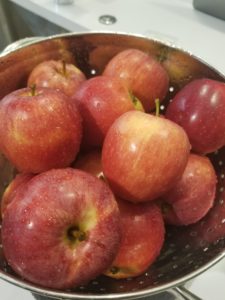
Everyone has their favorite fruit, or at least should. Some people go gaga for watermelon. Others say bananas are the best. Oranges may rank at the top for just about anyone. Me, I really can’t say I have a favorite. I know which ones I don’t care to consume unless they are presented in a interesting way, which would be melons and figs. Something about the mustiness flavor of both throws me off. But a few slices of watermelon with ricotta, cracked pepper and a drizzle of extra virgin olive oil is divine. A fig compote topped on a nicely grilled pork chop is a party in your mouth. Having the diverse palate that I have I swing from the strange, exotic stuff like say horned melon to the more basic items like strawberries. Oh wait that’s not a fruit technically.
Which leads me to this post. I don’t know if it’s being born and raised in New England or the fact that there are so many culinary ways of using them but apples place at the top of my favorites. I can’t even begin to to list how this humble group can transform an ordinary dish to something stellar. Not to mention if you find yourself at a farmers market they should have heirloom varieties that will fit any which way your mouth desires. Of course, an American tradition, especially this time of year, is Apple Pie. Now the recipe that follows is for canning the filling, saving that fall flavor for later in the winter. If you’re in dire need of a recipe for a pie that needs to go in the oven ASAP, message me and I’ll be happy to give you one. Otherwise, get out there, pick your own from a local farm, stop buy a booth at a farmer’s market, which may be ending this time of year, or head to grocery store to snag some. Just remember, don’t buy “Red Delicious” as they are never delicious and they are definitely not the apple of my eye.

APPLE PIE FILLING
- 5 #’s Apples
- 6 C water
- 1 1/2 C sugar
- 3 sticks Cinnamon
- 1 T freshly ground Nutmeg
- 3 T Corn Starch
- 3 T Citric Acid
- 1 t Salt
- juice of 1/2 Lemon
You’re going to want to start the “brine” before you start peeling the apples. Apples will brown quickly due to oxidation so peeling and slicing them should be the last step. Combine the water, sugar, cinnamon and nutmeg and bring to a boil. Reduce heat and simmer for 15 minutes. This will really help the aromatics infuse into the liquid. Mix the corn starch into just enough water to make it pourable. When the timer goes off, pour the slurry into the pot, whisk and bring back to a boil. Cook for a minute or two whisking to make sure there is no clumps and remove from heat.
Next up is peeling and cutting the apples. Firstly, combine the citric acid with the salt and lemon juice, if you can’t find citric acid, increase the amount of lemon juice to a whole lemon. If you feel good about using a paring knife to peel the apples, you should as the ribbon of skin will come in handy for the next recipe. If not, a regular peeler will work but save the skins of either! Don’t peel all the apples at once, do it in several batches to avoid them turning brown before being cut. In my experience, most everyone who’s eating apple pie is just happy to be eating apple pie and not looking to see how pretty it is between shoveling it down their throat. Add the apple to the citric and lemon, give them a gentle toss and repeat until apples are gone.

Split the apples between 3 quart jars, packing them in but not mushing the fruit. Any remaining pieces set aside for later. Pour the spiced liquid over the apples, remembering to leave enough head space. If you like, save any leftover liquid to make an alcoholic beverage with later. It would be an excellent mixer for a warmed whiskey drink but would also be fantastic thinned out with some hot water for a relaxing drink on a cold Autumn night.
Follow the general guidelines for canning for your altitude.
Now if you’re still reading this, thank you firstly and secondly, you deserve a bonus recipe. “Cabbage Stew” may not sound that sexy but it’s a really tasty dish. Not to mention it’s hearty, quick to make and freezes well for future use. So let’s get to it!
CABBAGE STEW
- 1 medium Yellow Onion, diced
- 3 Carrots, diced
- 2 stalks Celery, diced
- 4 cloves Garlic, sliced
- 1 medium to large head of Green Cabbage
- 28oz can diced tomatoes
- 3 T dried Oregano
- 2 T dried Parsley
- 2 Bay Leaves
- leftover apple pieces and skins
- 3 T olive oil
- water
- salt to taste

If you’re using leftover apple pieces, give a quick rinse to get off the citric acid & lemon juice. Over medium high heat in a large pot warm the olive oil in a large pot. Add the onion, carrot, celery and garlic and stir frequently for a few minutes. Add in a about a cup of water and bring mixture down to a simmer. Now I should say that if you’d like to use stock instead of water, feel free to but I would stay away from anything except vegetable stock as the flavors of others may not work with this stew. While your mirepoix is softening, cut your cabbage into quarters, removing only the thickest part of the stem. Using the slicer blade on the food processor, add each quarter. If your cabbage is especially large, there may need to be some more downsizing done to fit in the chute. In between each segment, shred a handful of apple peels and mix with the cabbage. Once this part is done add in the cabbage/apple mixture, apple pieces, tomatoes and herbs to the pot. Follow that with enough water (or stock) to cover the stew. You don’t want too much liquid as the cabbage is going to kick out some juice as it cooks and you can always add in more during the cooking process. Turn heat up and depending on how much time you have, or really how hungry you are, simmer or low boil until the cabbage is al dente. Serve with a nice piece of crusty bread and maybe a little bit of grated parmesan on top.
Rhubarb Pie
- At May 23, 2017
- By megan
- In dessert, Martha Stewart, pie, pie crust, rhubarb
 0
0
Chef Sean Smith is a fan of Martha Stewart’s recipes because they are easily multiplied. That essentially means she nails the ingredient ratios so if you’re making a double or triple batch of cookies, you can be confident that doubling or tripling her recipe will end up with something delicious. So, when I was tasked with making a pie for our clients, I went right to Martha.
The recipe starts by suggesting you make this pie the day before you plan to serve it, which is exactly what I did. I suggest you make your pie crust first and keep it cold in the refrigerator. Make your crumble topping second and keep it cold in the fridge as well until you’re ready to sprinkle it on top of the filling. Below you’ll find three sections: dough, filling, and crumble topping.
Ingredients for the Pie Dough:
- 2.5 cups all-purpose flour
- 1 teaspoon sugar
- 1/2 teaspoon fine salt
- 2 cups cold butter, cut into small cubes
- 1/4 (or a little more if needed) ice water
The easiest way to make dough is to add the flour, sugar, salt, and butter to a food processor and give it a whirl. Then slowly add the ice water until it’s dough. Finish by forming it into a ball, wrap it in parchment paper, and refrigerate until you’re ready to use it.
Ingredients for the Pie Filling:
- All- purpose flour, for dusting
- 1 3/4 pounds (approximately 6 cups) rhubarb with the ends trimmed and cut crosswise into 3/4 inch pieces
- 1 cup sugar
- 2 tablespoons cornstarch
- Pinch of salt
Ingredients for Crumble:
- 3/4 cup flour
- 1/3 cup packed light brown sugar
- 3 tablespoons sugar
- pinch of salt
- 6 tablespoons chilled butter
And now to make the pie! Here’s my pie before baking, just for reference.
- Place the pie dough on parchment paper and roll it out to fit in a 9 in pie pan. Fit the dough into the pan, trim/crimp your edges, and refrigerate for an hour.
- Preheat oven to 400 with the rack at the lowest level.
- Add the crumble ingredients to a bowl and mix until the butter is somewhat evenly distributed. Chill in the fridge until you reach step 5.
- In a large bowl, toss the rhubarb with sugar, cornstarch, and salt.
- Pour filling into the pie crust, distribute it evenly, and sprinkle the crumble topping on top.
- Place pie pan on a foil-lined rimmed baking sheet. This is important as it will help clean up be a synch!
- Place your pie in the oven and lower it to 375 degrees. Bake for approximately 1.5 hours and cool completely before serving.
Mother’s Day Private Chef Dinner
- At May 15, 2017
- By megan
- In Personal Chef, pie, Potato, Private Dining, rainbow chard, Sean Smith
 0
0
Chef Sean and I had the honor of cooking a three course dinner for clients to celebrate Mother’s Day this year in downtown Boulder. He was in charge of everything except the Rhubarb Pie, which I successfully put together the day before.
I set the table for four while he was busy cooking. The first course was delectable- Crab cakes with a watercress, mizuna, and apple salad and a champagne mustard vinaigrette.
The second course was planned for the Texans visiting family in Boulder: Steak and potatoes.
Chef Sean made twice baked potatoes filled with pancetta, roasted garlic, parmesan, ricotta, and green onion served on top of sautéed spinach and chard from the Boulder Farmer’s Market. The steaks were topped with a relish of roasted peppers and pickled chilies (he pickled the chilies last summer during pepper season at the market).
We ended with my Rhubarb Pie.
It’s always fun cooking for hungry clients. Please let us know what we can cook for you!
Cheers~

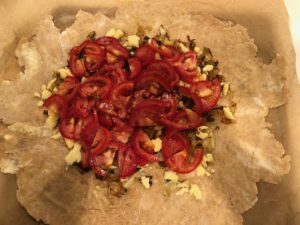

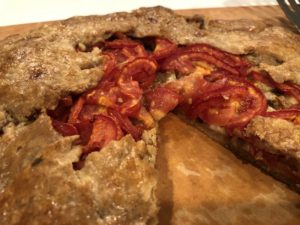
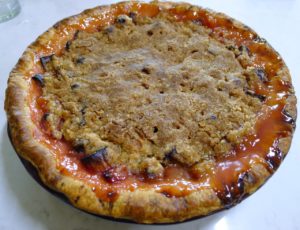
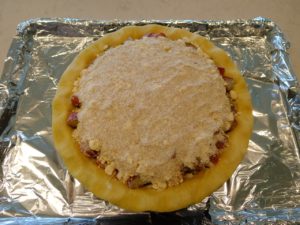



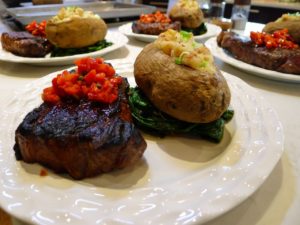
Let’s get Social